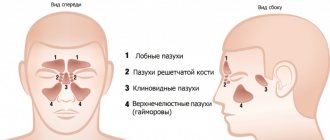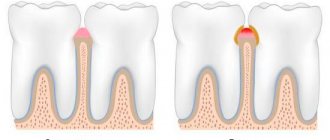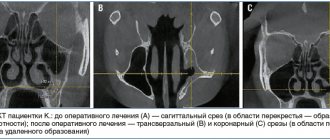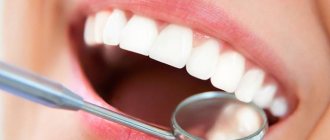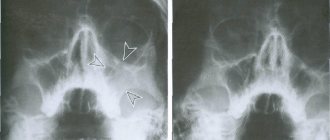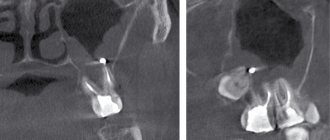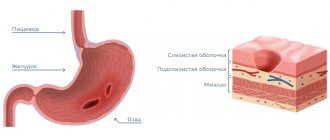- What is maxillary sinusitis?
- Symptoms
- Complications
- Types and types of maxillary sinusitis
- How is maxillary sinusitis diagnosed?
- Treatment
- Etiotropic therapy
- Puncture
- "YaMiK"-catheterization
- Treatment of symptoms of maxillary sinusitis
- Surgical intervention
- Treatment at home
- Prevention
Maxillary sinusitis (from the Latin “sinus” and “inflammation”) is an inflammation of the mucous membrane of the corresponding sinuses. The causes of this disease are various: allergies, rhinitis, diseased teeth, inflammation of the tissues around the teeth, injuries. Treatment includes conservative procedures, home remedies, and surgery.
What is maxillary sinusitis?
A person has several types of sinuses: frontal, sphenoid, maxillary and cells of the ethmoid labyrinth.
In each of these types, inflammation of the mucous membrane can occur. Then sinusitis will begin. Maxillary sinusitis is otherwise called sinusitis and is an inflammation of the paranasal sinuses. The maxillary sinuses were first illustrated by Leonardo da Vinci, and the disease itself was discovered by Nathaniel Highmore, a British surgeon and anatomist (he also described the maxillary sinuses in detail in his treatise of 1651). At that time, sinusitis was treated with home methods and heating.
What is called subtotal darkening of the maxillary sinuses?
Subtotal darkening of the maxillary sinuses is a radiological sign that indicates an inflammatory process in the organ. Darkening is also observed with the development of pathological changes in the mucous membrane.
Sometimes darkening may indicate the development of tumors in the sinus area. They can be either benign or malignant. The development of cysts is often detected using x-rays.
But most often, darkening on an x-ray indicates an accumulation of pus. Its detection indicates a disease such as sinusitis.
Types and types of maxillary sinusitis
Depending on the etiology (cause of occurrence) of the disease, rhinogenic, odontogenic, traumatic and allergic maxillary sinusitis are distinguished.
Rhinogenic sinusitis occurs against the background of rhinitis (when the nasal mucosa becomes inflamed). The mucous membrane is the main obstacle to infections. When bacteria gets on it, a runny nose or rhinitis develops. The causes of rhinitis are different: viruses, hyperthermia, allergies.
, decreased protective properties of the body, penetration of synthetic agents, influence of dry air, too long use of drugs with a vasodilator or vasoconstrictor effect.
Rhinitis is characterized by congestion, nasal discharge, impaired circulation in the nasal cavity, and the development of congestive blood phenomena. There are 4 types of rhinitis: allergic
, chronic, acute, vasomotor.
Odontogenic sinusitis occurs due to inflammation of the mucous membrane of the maxillary sinus due to infection from an unhealthy tooth, the tissues around it, and the communication formed between the sinus and the oral cavity after tooth extraction. Symptoms of this disease can be apathy, loss of appetite, headache, aching temples, discharge from the nose or ear, cough, runny nose and others. Depending on the course of the disease, different treatment methods are chosen: antibacterial therapy and washing of the maxillary sinuses, pumping out pus or surgery.
Injury to the maxillary sinus or jaw can also lead to sinusitis.
The cause of allergic sinusitis is the body's hypersensitivity to one of the irritants. The disease begins in the nasal cavity and then spreads to the maxillary sinuses. What usually serves as an allergen? This is pollen during the flowering period, fur and excrement of pets, dust mites, medicines, household chemicals, perfumes, cosmetics, chemicals, dirty city air.
According to the duration of the disease, sinusitis is divided into:
- acute (less than 3 months);
- recurrent acute (can repeat up to four times a year);
- chronic (more than 3 months);
- exacerbation of chronic sinusitis (adding new symptoms to existing ones).
According to the severity of symptoms, sinusitis is:
- lungs
- moderate severity
- heavy.
Complications
Nasal polyps can lead to complications because they interfere with the free passage of air and the drainage of mucous secretions from the sinuses.
Possible complications with nasal polyposis:
- Obstructive sleep apnea. In this condition, prolonged pauses in breathing occur during sleep, which increases the risk of cardiovascular disease and sudden cardiac death.
- Progression of bronchial asthma. Polyposis can aggravate the course of bronchial asthma.
- Sinus infection or infectious complications of chronic sinusitis. Nasal polyps increase the frequency of exacerbations of sinusitis and can lead to serious complications (for example, meningitis, orbital phlegmon, sepsis).
How is maxillary sinusitis diagnosed?
When diagnosing a disease, it is necessary to collect a number of indications: find out about complaints, write down symptoms, analyze the patient’s medical history and conduct an examination (computed tomography, x-ray).
Possible symptoms: headache, temporal pain, nasal and ear discharge, accumulation of mucus in the back of the throat, intoxication (in severe cases).
The medical history should contain information about past illnesses, injuries, hypothermia, etc.
The examination usually consists of palpation and percussion in the area of the paranasal sinuses, and also includes pharyngoscopy and rhinoscopy.
Diagnosis of the disease
Your doctor can determine the condition based on your answers to questions about your symptoms, a physical examination, and rhinoscopy (a visual inspection of the nasal cavity using a light and a nasal speculum). But additional examination may be required to determine treatment tactics.
Additional diagnostic tests for polyposis:
- Endoscopic examination. Using an endoscope, the doctor can conduct a thorough examination of the nasal cavity.
- X-ray tomography. Images obtained by X-ray computed tomography (CT) provide information about the extent of polyposis involvement in the nasal cavity or sinuses. These tests can also help the doctor detect the presence of other abnormalities, such as a deformed nasal septum or enlarged nasal turbinates. Based on RCT images, the doctor may suspect a tumor growth other than polyposis (malignant or benign).
- Allergy detection. The doctor may prescribe an additional test to identify allergies: rhinocytogram, blood test for IgE, eosinophilic cationic protein, scarification tests. This is necessary in order to identify the presence of allergic pathology, which contributes to the development of polyposis.
- Test for cystic fibrosis (cystic fibrosis). A child diagnosed with chronic polypous sinusitis should be evaluated for cystic fibrosis. This is a hereditary disease that disrupts the secretion of glands, which leads to chronic inflammation of the respiratory tract and the development of polyposis.
Treatment
Etiotropic therapy
Prescribing antibacterial agents (the main causative agents of acute sinusitis) helps to achieve rapid results in therapy:
- β-lactams: amoxicillin, clavulanate, cefaclor, cefuroxime axetil, sulbactam;
- fluoroquinolones: levofloxacin, gatifloxacin, moxifloxacin;
- macrolides: azithromycin, clarithromycin.
Puncture
This method is used if the disease cannot be cured with medication. It is the most famous method for removing pus from the maxillary sinuses. Quite painful, unlike other procedures.
"YaMiK"-catheterization
A fairly effective remedy in the fight against maxillary sinusitis, it does not cause complications. The procedure is quite painful, like puncture; patients cannot always tolerate it well.
Important: the operation is not advisable for isolated lesions of one paranasal sinus, since infection can be introduced into healthy paranasal sinuses.
Causes of hypertrophy
Thickening of the mucous membrane of the maxillary sinuses can develop as a result of many predisposing factors.
The main reasons are as follows:
- Weakening of the immune system.
- Insufficient intake of minerals and vitamins into the body, chronic vitamin deficiency.
- Exposure to the mucous membrane of toxic substances and toxic vapors.
- Chronic diseases of the upper nasal passages with regular exacerbations.
- Long-term smoking.
- Injuries to the nasal septum causing curvature.
- Frequent colds and viral diseases.
- Tendency to allergic manifestations, rhinitis of allergic origin.
- Dry air in the room when the air conditioner or heater is running.
- Environmental factors, such as air pollution.
- Long-term use of hormonal drugs in large dosages.
- Long-term treatment using vasoconstrictor nasal drops.
- Congenital anomalies of the development of the mucous membrane or nasal septum.
- Neurovegetative pathologies in which pathological vasodilation occurs in the absence of other symptoms of thickening of the mucous membranes.
- Pathologies of the teeth of the upper jaw, causing inflammation and thickening of the mucous membranes.
In addition, the pathology is more common in children, which is associated with imperfections of the mucous membrane and frequent colds affecting the nasal passages. Additionally, children are more prone to allergic diseases.
Treatment of symptoms of maxillary sinusitis
Symptomatic treatment of sinusitis includes topical decongestants (such as xylometazoline and oxymetazoline) that improve sinus ventilation, mucolytics (such as carbocysteine) that improve mucus secretion, topical antiseptics (miramistin and others) and irrigation therapy (such as nasal douches). , before using which you need to use vasoconstrictor drugs), which flush out mucus and kill microbes in the sinus cavity, topical glucocorticosteroids, combined drugs (non-steroidal and anti-inflammatory drugs - paracetamol, ibuprofen).
Among the most effective drugs for treating the symptoms of sinusitis are
Sialor based on silver ions . It has an anti-inflammatory effect and prevents the proliferation of bacteria. Thanks to the mild action of the drug, the balance of microflora is maintained and favorable conditions are created for the regeneration of the nasal mucosa.
Surgical intervention
Drug treatments are not always effective; sometimes it is necessary to resort to surgery. At the same time, both approaches to diseased sinuses (extranasal, endonasal, combined), surgical technologies (magnifying devices and lighting devices), and surgical methods differ.
Important: after sinusitis, patients should be periodically (at least once every 3 months) observed by an otolaryngologist.
Treatment at home
An option for treating maxillary sinusitis at home is steam inhalation, which improves blood circulation, thins mucus accumulations, and also improves the flow of medications from the blood. But in acute cases of maxillary sinusitis, this method is dangerous; it can provoke generalization of the infectious process.
You can do inhalations with a decoction of herbs (calendula, celandine, bay leaf, string of sage, chamomile). Add alcohol tincture of propolis (1 teaspoon per 0.5 liter of decoction) and a couple of drops of iodine to boiling water.
In addition to such inhalations, you can also breathe over boiled potatoes. Important: you need to breathe for 10 minutes every day, the course is a week.
Warm the nose with table salt in a bag, boiled with an egg, and a blue lamp. Rinse the nose with the following solution: 1 teaspoon per glass, furatsilin (2 tablets), herbal decoctions (sage, celandine, chamomile). The procedure can be repeated up to 10 times a day.
The mechanism of changes in the structure of the mucosa
Thickening of the mucous membrane develops gradually, especially in patients whose immunity is not weakened. When the maxillary sinuses are affected, the damage begins with the development of swelling of the mucous membrane, as well as blocking of the ducts through which mucus is excreted.
Thickening of the mucous membrane of the maxillary sinuses
These secretions cannot be removed through the ducts, so the swelling intensifies, which worsens the patient’s condition. Pressure increases in the sinuses, which leads to the formation of cysts and polyps. If, before the development of edema, pathogenic microorganisms enter the sinus cavity, pus is formed when the ducts are blocked and the mucous membranes swell.
This development mechanism is observed in most cases. When the pathological process is mild, there are no microorganisms in the cavity, which reduces the likelihood of complications.
Establishing diagnosis
Several examination methods are used to make a correct diagnosis. The initial stage is a general examination and interview of the patient, listening to complaints and identifying the conditions for the appearance of symptoms of the disease. After this, the doctor prescribes a general and biochemical blood test.
These studies are mandatory because they help identify common signs of inflammation. After this, the patient is sent for fluoroscopy of the maxillary sinuses. In the image, the specialist can see deviations from the bones, especially the nasal septum.
The next stage of the examination is rhinoscopy. This method is a study of the nasal passages with a special device. At the same time, the doctor notes the degree of damage to the mucous membranes and detects possible complications.
If necessary, magnetic resonance imaging is prescribed, which allows you to see polyps and other neoplasms, as well as complications. Based on diagnostic data, treatment is prescribed.
Cyst in the sinus: surgery, reviews
Patient reviews give preference to the endoscopic method of cyst removal. When performing the classical method and laser vaporization, an incision is required under the upper lip to gain access to the cyst. Classic removal of a sinus cyst involves dissection of the soft tissue under the upper lip from the frenulum to the first molar (Caldwell-Luc method) or using the Denker method, which is also carried out through the facial part. Classic operations are more traumatic, with long postoperative recovery, but these techniques allow you to gain access to a cyst located in a hard-to-reach place. Endoscopic removal is carried out using an endoscope, the cyst is removed through a small burr hole, the operation is performed under local anesthesia.
At the Yusupov Hospital, patients will be able to undergo a full examination using modern diagnostic equipment. The hospital hosts doctors from various fields, there is a clinical laboratory, and a rehabilitation center. In the hospital you can recover from surgery or illness, and patients have a 24-hour inpatient facility.
